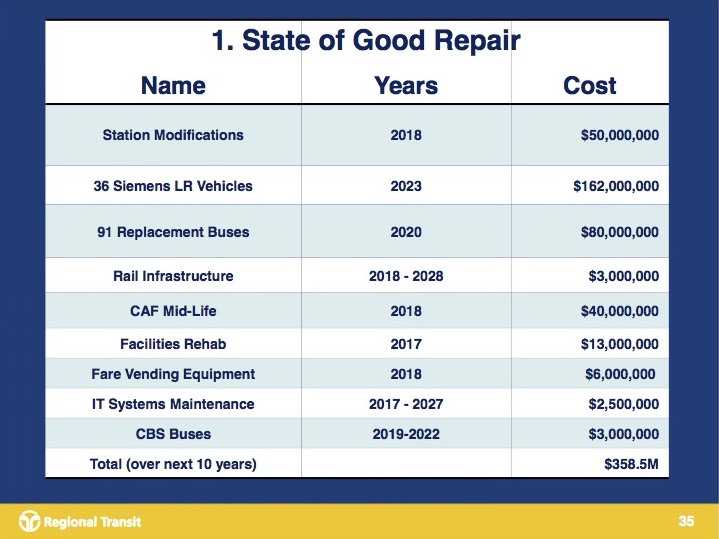State of good repair is a phrase used in many fields, but particularly in transit. It means that everything is on a functional state and not declining, that it is maintained when it needs maintenance, and replaced when it needs replacement. The Federal Transit Administration’s State of Good Repair page says:
Having well maintained, reliable transit infrastructure – track, signal systems, bridges, tunnels, vehicles and stations – will help ensure safe, dependable and accessible services.
State of good repair is used by SacRT in budget documents and in the strategic vision. SacRT has done reasonably well with its bus fleet, buying new buses every few years, and maintaining what they have at an acceptable level. Bus break-downs are not common. Some old buses are retained but not used regularly, mostly to accommodate the occasional need for bus bridges when light rail breaks down or is stopped by outside forces (most often vehicle crashes and trespasser incidents).
On the other hand, the light rail system is anything but in a state of good repair. The three generations of rail cars are all old. The newest set is due for major rehabilitation, the oldest set is due for replacement, and the cars obtained from VTA, though they were rehabilitated, are still old. The cars break down often enough that some trains are short, running fewer cars than demand indicates. The power systems breaks down as well, leaving the train SRTS without power. A lot of the track miles are in poor condition, leading to rougher rides and slower speeds, both because they have aged and because they were not installed at a high quality to begin with.
I understand that SacRT facilities are also in poor condition, both the offices scattered over several blocks in midtown, and the bus maintenance facility in midtown. I am not sure about the light rail maintenance facility on the Blue Line between Swanston and Marconi/Arcade stations.
Below is the state of good repair slide from SacRT’s Strategic Vision presentation. Lines one, two, four and five are all related to light rail, and total $265M. That’s a lot of money! STAR has recommended a complete fleet replacement all at once, rather than in stages, so that the system would be all low-floor level-boarding with new platforms throughout and no interim solutions needed. But this would be even more money, perhaps another $100M. Whichever alternative is pursued, SacRT does not have this level of funding currently, which is why it needs additional sources of income. Federal grants can help, and in fact there are FTA State of Good Repair grants, however, most of the funding would need to come from state and local resources. A dedicated transit tax is one method for generating local funds.
